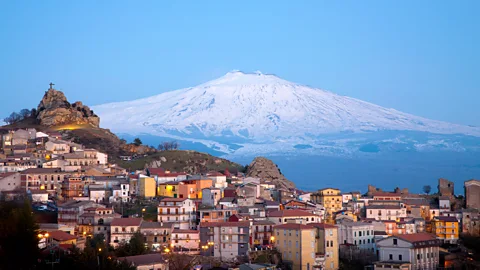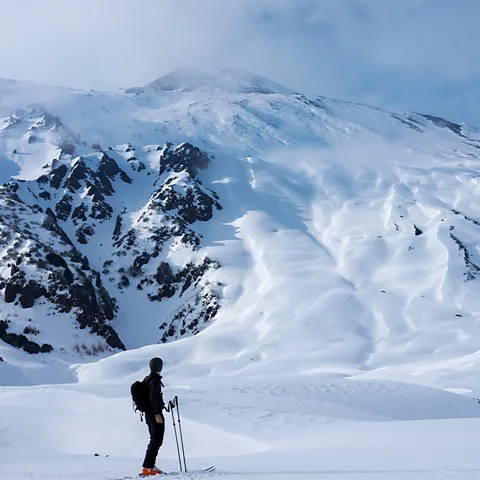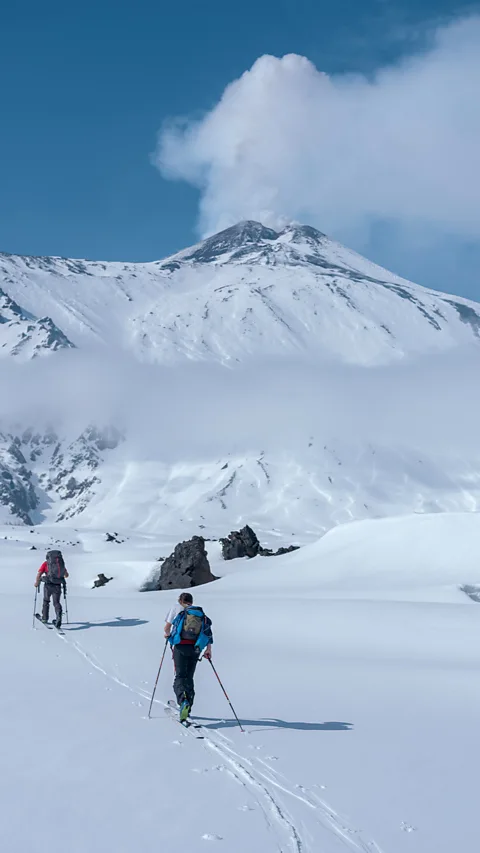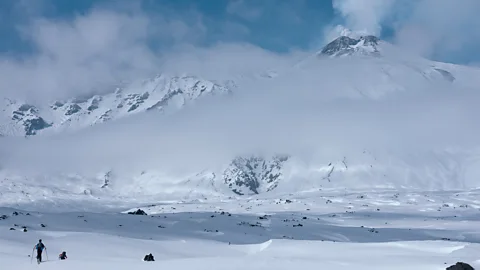Skiing Mount Etna, Europe's tallest and most active volcano
 Blueplace/Getty Images
Blueplace/Getty ImagesMost people don't think of snow in Sicily. But the Italian island's rumbling peak offers one of the world's most unforgettable skiing experiences.
Standing at an altitude of 3,000m, I peered down across a glistening expanse of virgin snow blanketing Europe's tallest and most active volcano. It had been snowing for several days, and my guide, Elis Martis, said he'd never seen white stretch so far down Mount Etna's flanks. He pointed to our destination far away in the horizon, where the blue sea met the clear blue sky, and then we set off, skiing down the volcano at a blistering speed, our skis gliding through the light, fresh powder.
Most people don't picture snow-covered peaks when they think of Sicily. But in the highest elevations of the Italian island, temperatures plunge and snow falls come wintertime. Hot, dry winds called the scirocco drift north from the Sahara Desert, picking up moisture as they cross the Mediterranean Sea. These gusts converge with cooler, drier air descending from the north, creating a meteorological phenomenon that buries Sicily's mountains with snow.
I first met Martis on a skiing trip to the Italian Dolomites in 2020. A mountain guide and Italian skiing expert, Martis told me stories about mind-blowing ski runs on the Mediterranean's largest island that were hard to believe. So, in February 2023, we flew to the coastal Sicilian city of Catania then drove 50km to Etna Glo Bed & Breakfast at the foot of the volcano for an unforgettable adventure.
As we drove towards Etna, Martis described why skiing on the volcano is like nowhere else in the world. He explained that due to the proximity to the sea, fresh snow here is so moist that it quickly forms a dense, load-bearing layer of powdery snow that allows skis to easily glide. The white powder alternates with black lava rocks, creating surprising contrasts, all while clouds of smoke billow from Etna's rumbling crater. "This, combined with stunning views of the sea in the distance and incredible Mediterranean cuisine provide an experience beyond description," he said.
 Louis Supple
Louis SuppleGiuseppe Cobo, a local skiing enthusiast and the owner of Etna Glo, rushed to greet us as we pulled up outside his B&B. After serving us a plate of blood oranges from his family orchard, Cobo explained that skiing is a long-standing tradition on Etna. In winter, Cobo said his grandparents went to collect firewood at the base of the mountain on skis. There were no refrigerators back then, so his grandparents would also collect small crates of snow from the woods and store it in cabins over the winter months. At the first sign of spring, they returned to the cabins to collect the ice that had formed and used it to preserve food. This centuries-old tradition was first introduced by the Romans, who ruled Sicily starting in the 3rd Century BCE. By the 9th Century, the island's Arab rulers blended Etna's ice with sugar and citrus fruits to make sherbet, a recipe that lives on in the Sicilian specialty granita.
Yet, skiing on Etna as a sport dates to the 1930s, when a small group of local endurance athletes began ski mountaineering. Unlike resort skiing, where you're typically whisked up a mountain on a lift and you then ski down a marked trail, ski mountaineering involves either cross-country skiing or climbing up to the summit of the mountain while carrying your skis, and then racing back down the mountain through wild terrain on an unmarked trail.
Skiers from mainland Italy and Europe began travelling to Etna after the construction of the first cable car in the 1950s, which transported skiers up the mountain to an altitude of 2,500m. However, the boom in skiing on Etna really started in the '60s and '70s when the ski resorts of Etna Sud and Etna Nord were built. Patricia Pavoni, a lift attendant at Etna Sud, explained that skiers from all over the world now travel to Etna to ski. "Every year we receive more guests from Asia and North America," she said.
Today, Etna's resorts remain small compared to popular European ski destinations. Etna Sud on the volcano's southern slope has five ski lifts, while Etna Nord on the northern slope has just four. In comparison, Chamonix, one of Europe's most popular ski resorts at the base of Mont Blanc, has 69 lifts. "Our guests don't come because we have the most ski runs in Europe, they are more attracted by the prospect of skiing on our magnificent volcano and the Mediterranean atmosphere," Cobo said.
 Louis Supple
Louis SuppleCobo learnt to ski in Etna's resorts as a child but now prefers ski mountaineering. "For me, Etna is the paradise of ski mountaineers. You can enjoy unique views far from the crowds, sea on one side and craters on the other," he said. In recent years, there's been a notable increase in participation and media coverage of ski mountaineering, leading to its inclusion as an Olympic sport for the first time in the upcoming 2026 Winter Olympics in Cortina, Italy.
Like Cobo, I have primarily skied at resorts for the past decade, but in recent years, I've grown to love ski mountaineering. I enjoy the satisfaction of climbing a mountain on my own steam and the thrilling payoff of a descent on untouched snow. Ski mountaineering allows you to reach remote terrain, while letting you enjoy prolonged moments of solitude and a connection with the natural environment. I seek out ski mountaineering destinations like Etna that also have interesting culture and history.
Few people are as familiar with Etna's rarely traversed unmarked slopes as Martis, who has guided skiers up and down Etna for more than a decade. He recommended we head to the Valle del Bove, an immense amphitheatre on Etna's eastern flank hemmed in by 1,000m rock walls whose steep slopes of light, powdery snow are perfect for ski mountaineering. "After traversing the Valle del Bove, you can ascend a slope to Etna's summit. The views of the volcano crater are spectacular," Martis said.
Local skiing enthusiast Salvatore Rizzo joined Cobo, Martis and I for the adventure. We drove a short distance from the B&B to where the snowline in the Valle del Bove started. We then assembled our ski-touring equipment: thin, lightweight skis and synthetic "skins" that attach to the base of the ski and provide grip for skiing uphill. We also carried an avalanche transceiver, although Martis assured us that we wouldn't need to use it.
 Louis Supple
Louis SuppleAs we settled into a meditative rhythm cross-country skiing across the Valle Del Bove, Rizzo explained the unique relationship between Etna and the locals that live in its shadow. "We have an irrational love for Etna. Sometimes she is calm and sometimes she is angry. When she is angry, she can destroy everything we have, but we always go back," he said.
Etna's earliest recorded eruption was 1500 BCE, but since November 2022, it has rumbled four times – most recently in August and November 2023 when it spewed hot lava into the air, temporarily shutting down the airspace over the island. In the sleepy town of Zafferana Etnea, where his B&B is located, Cobo showed us buildings that were damaged by lava streams in 2013.
"Etna is a treasure chest for volcanic scientists because its intense activity allows us to closely study the volcano's inner processes," explained Sarah Booth, a volcanologist staying at Etna Glo. "This information helps us create more effective tools to monitor the volcano's behaviour."
Though Etna's eruptions have often caused destruction, they have also bestowed good fortune on the area. Today, the region surrounding Etna is one of the most prosperous and densely populated areas of Sicily, thanks in large part to the fertile volcanic soils that support robust citrus cultivation and wine production. Sicily is Italy's largest wine region with 242,000 vineyard acres (98,000 hectares). "The volcanic soil around Etna has a unique combination of minerals, which are perfect for wine grape growth. The soil here is special, you will not find it elsewhere," said Lucrezia Marino from the Oro winery near Zafferana Etnea.
 Louis Supple
Louis SuppleWe passed signs of Etna's past blasts as we skied, as clusters of rough and jagged black, volcanic rock lined the valley. After five hours traversing across the Valle del Bove, we reached a steep slope, which lead up to Etna's summit. We zigzagged up using kick turns, an awkward-looking manoeuvre that involves skiing diagonally uphill across the slope in one direction and then sharply turning to ski in the other to soften the slope's gradient.
Reaching Etna's summit, I took a moment to admire the 360-degree panorama. I peered down across Catania, the Ionian Sea and as far away as Calabria on the Italian mainland. I then removed the skins from my skis, adjusted the bindings and promptly set off down the volcano in pursuit of Martis in the distance.
---
Join more than three million BBC Travel fans by liking us on Facebook, or follow us on Twitter and Instagram.
If you liked this story, sign up for the weekly bbc.com features newsletter called "The Essential List". A handpicked selection of stories from BBC Future, Culture, Worklife and Travel, delivered to your inbox every Friday.
